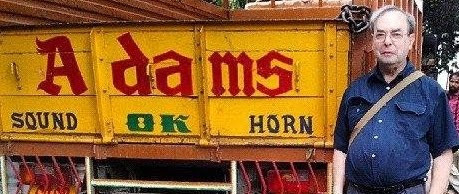In
late November, early December 2015, I visited the southern Indian coastal city
of Pondicherry (‘Pondi’). Until 1954, this small place on the coast of the Bay
of Bengal was a French colony. Now, it is an Indian Union Territory. When the
French left in 1954, the ethnically Indian (mainly Tamil) inhabitants of Pondy
were offered the opportunity of becoming French citizens. Many accepted. So, at
present many of the inhabitants of Pondi are still French subjects, and enjoy
the benefits associated with this status. Apart from architecture, there are
many left-overs from Pondi’s days as a French colony. For example, policemen
wear red képis on their heads and
street signs are bilingual: Tamil and French.
There
is a church close to Pondy’s railway station, Basilique Sacre Coeur (Sacred
Heart Basilica). This is an airy Gothic revival edifice, which was built
between 1902 and 1907, when the first mass was held in its eastern wing. The
church was completed by 1908[1]. While walking around the
church, I noticed some particularly fine stained glass windows in the south
wall of the nave. Each one of the windows depicted a saint, and below each
saint was his or her name. To the right of each name was an inscription: “Strassburg
1908”, and to the left: “OTT Fres”.
My
interest was immediately heightened. Strassburg was the German name for the now
French city of Strasbourg. However in 1908, the city was under German
administration. It had been since France was defeated in the Franco-Prussian
War of 1870-71, and was to remain so until the end of the First World War (‘WW1).
“OTT Fres” was, I assumed, an abbreviated form of OTT Frères, which I guessed
(correctly) was the manufacturer of the stained glass.
On
my return to the UK, I looked up ‘OTT Frères’ on the Internet, and was
gratified to discover that such a company existed. OTT Frères (OTT brothers) was
a company of stained glass painters based in in Strasbourg/Strassburg. They furnished windows
for a variety of buildings (churches and other public buildings) in Alsace,
especially in the city of Strasbourg/Strassburg during the first two decades of
the 20th century[2]. A set of postcards issued
in about 1920 (see below) illustrates the interior of the OTT workshops[3]. The company was founded
in the 1850s[4],
and by 1900 its workshops opened onto the Cour du Corbeau. The company remained
in existence until 1975[5]. Clearly, as I discovered,
some of its creations travelled a long way from Alsace.
It
is of interest to note that the (French) builder of the church in Pondy chose
to commission windows from a company in enemy (German) occupied Alsace, but he
did. However, not all of the windows in the church were made by Ott Brothers.
Some, which seemed newer in design than those made by Ott and not nearly as
finely executed, were manufactured by a company in Grenoble.
Strasbourg/Strassburg,
like Pondicherry, changed hands. The city remained under German control for
about 47 years, whereas Pondy remained under French control for far longer:
from 1674 until 1954.
I
have some French relatives living in present day Strasbourg. They have been
there for several generations, having moved there from southern Germany at the
end of the 19th century. When Alsace-Lorraine was occupied by the
Prussians in 1870-71, another of my many ancestral relatives, quite unrelated
to those of my family who live in Strasbourg today, was a soldier in the
Prussian Army. This man was Leo Ginsberg (1845-1895), who was born in Prussia
(Breslau) and was the half-brother of my great-grandfather the South African Senator
Franz Ginsberg (1862-1936). Leo settled in the occupied Alsatian city. One of
his grandchildren told me that when Leo married, he and his wife were required
by law to purchase a set of china dishes from the royal Prussian porcelain factories.
Leo had 4 children, all of whom migrated
to South Africa, where they lived in King Williams Town in which their uncle
Franz had settled in 1880.
We
would never have visited Sacre Coeur had I not wanted to see Pondy’s railway
station, which turned out to be a bit of a disappointment visually. Since the
church is across the road from the station, we felt that we should take a look
at it, and I am glad that we did, as doing so revealed a tiny aspect of
colonial history.
NOW VISIT
ADAM YAMEY'S
WEBSITE:
FOR SOME MORE WORKS OF INTEREST
[1] https://en.wikipedia.org/wiki/Basilica_of_the_Sacred_Heart_of_Jesus,_Pondicherry
[2] http://www.archi-wiki.org/personnalite-ott_fr%E3%A8res-494.html
[3] http://www.hoogeduinpostcards.com/webshop/lots/59239--lot_of_9_postcards_france,_strasbourg,_vitraux_d-art,_ott_freres_(67).html
[4] http://www.cc-porte-alsace.fr/tourisme/livret-jep-2011-nfb-v4.pdf
& http://www.culture.gouv.fr/public/mistral/merimee_fr?ACTION=RETROUVER&FIELD_1=cmer1&VALUE_1=&FIELD_2=cmer4&VALUE_2=&FIELD_3=cmer5&VALUE_3=&FIELD_4=AUTR&VALUE_4=&FIELD_5=TOUT&VALUE_5=ott%20fr%e8res&FIELD_6=titre%20courant&VALUE_6=&FIELD_7=date%20protection&VALUE_7=&FIELD_8=DOSURLP&VALUE_8=%20&NUMBER=2&GRP=0&REQ=%28%28ott%20fr%e8res%29%20%3aTOUT%20%29&USRNAME=nobody&USRPWD=4%24%2534P&SPEC=9&SYN=1&IMLY=&MAX1=1&MAX2=100&MAX3=100&DOM=Tous
[5] https://www.facebook.com/media/set/?set=a.433426656788034.1073741843.366016053529095&type=3








